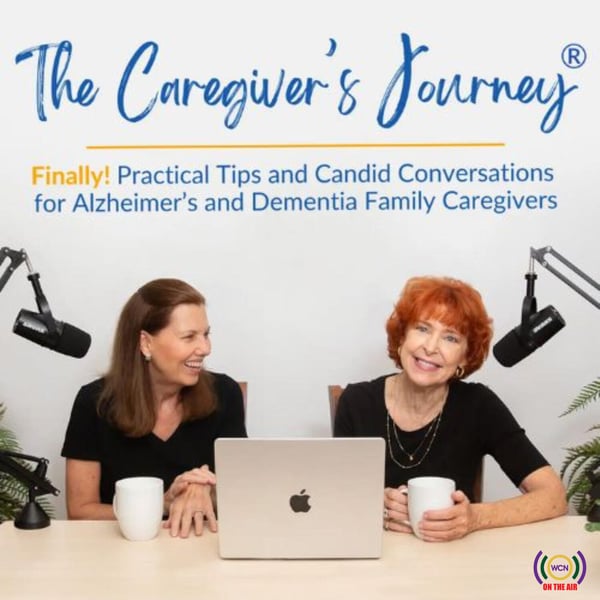Time for a Change? Tips When Considering Home and Community Living Options: Five Essential Tips / Alzheimer's and Other Dementias
The Caregiver's Journey
Sue Ryan and Nancy Treaster
5 • 1.9K Ratings
🗓️ 9 February 2025
⏱️ 34 minutes
🧾️ Download transcript
Summary
As caregivers for our loved ones with Alzheimer's and other types of dementia, we often face the challenging question: "Is it time to change my care receiver's living situation?" We are Nancy Treaster and Sue Ryan, and through our experiences, we've developed five essential tips to help you navigate this complex decision-making process.
Connect with us and share your tips:
- Website: https://www.thecaregiversjourney.com
- Instagram: https://www.instagram.com/thecaregiversjourney/
- Facebook: https://www.facebook.com/TheCaregiversJourneys/
- Linkedin: https://www.linkedin.com/in/suearmstrongryan/, https://www.linkedin.com/in/nancytreaster/
- Email: [email protected], [email protected]
Full Show Notes
https://thecaregiversjourney.com/time-for-a-change-home-and-community-living-options-five-essential-tips-alzheimers-and-other-dementias/
Takeaways
1. Understand Your Financial Resources
This foundational step requires a thorough assessment of both current and future financial resources.
Professional Resources to Consult:
- Financial advisors (especially those specializing in senior care)
- Elder care attorneys
- Government program specialists
Income Sources to Consider:
- Care receiver's savings
- Pensions
- Long-term care insurance
- Public health insurance (Medicaid in the US)
- Social Security disability benefits
- Family contributions
Expenses to Evaluate:
- Home modifications
- Safety adjustments
- In-home caregiving costs
- Day program fees
- Potential lost income if reducing work hours
- Care community costs
2. Research Care Options
There are three main categories of care options to evaluate:
Non-Residential Options:
- Respite programs
- Memory cafes
- Day programs
In-Home Options:
- Professional caregiving services
- Government programs (VA benefits, Medicare services)
- Family caregiver arrangements
Care Communities:
- Memory care specific facilities
- Communities with memory care units
- Different care models and staffing levels
- Waiting list considerations
3. Assess Home Safety
This evaluation should include multiple perspectives:
Medical Assessment:
- Get an updated medical evaluation
- Discuss current and future safety risks
- Request occupational therapy assessment
Key Safety Considerations:
- Wandering risk
- Cabinet and door safety
- Mobility challenges
- Fall prevention
- Depth perception issues
- Stairs and accessibility
- Emergency services access
4. Evaluate Medical Needs
Current and Future Medical Considerations:
- Impact of multiple diagnoses
- Care complexity
- Required medical procedures
- Medication management
- Physical care requirements
5. Prioritize Wellbeing for Both Care Receiver and Caregiver
This final tip focuses on quality of life considerations for everyone involved.
Socialization Needs:
- Care receiver's social preferences
- Community engagement opportunities
- Caregiver isolation prevention
- Balance of stimulation and comfort
Safety and Emotional Considerations:
- Physical safety for both parties
- Emotional wellbeing
- Caregiver burnout prevention
- Managing aggressive behaviors
- Personal boundaries
Making the Final Decision:
- Consider all evaluation points
- Involve family members
- Maintain awareness of available options
- Stay connected with potential care communities
- Be prepared to act when needed
Transcript
Click on a timestamp to play from that location
| 0:00.0 | This is the Whole Care Network, |
| 0:02.5 | helping you tell your story one podcast at a time. |
| 0:16.3 | Content presented in the following podcast is for information purposes only. |
| 0:22.7 | Views and opinions expressed in this podcast are solely those of the host and guests |
| 0:28.1 | and may not represent the views and opinions of the Whole Care Network. |
| 0:33.2 | Always consult with your physician for any medical advice. |
| 0:36.8 | And always consult with your attorney for any legal advice. And always consult with your attorney for any legal advice. |
| 0:40.5 | And thank you for listening to the Whole Care Network. |
| 0:53.1 | As caregivers, almost all of us at some point ask ourselves, |
| 0:58.4 | is it time to change my care receiver's living situation? |
| 1:03.3 | In this episode, Sue and I are going to talk about some of the early things you need to think about |
| 1:09.4 | when you're at this point. We have five |
| 1:12.9 | tips. Sue, let's get started. Welcome. We're Sue Ryan and Nancy Treister. This podcast brings our |
| 1:22.4 | years of experience in a variety of family caregiving roles to prepare you to navigate your |
| 1:27.3 | caregiving journey. |
| 1:28.5 | We're sharing our personal experiences, not medical advice, and because it's our passion to |
| 1:34.2 | support you on your journey, we believe no topic is off limits. Let's get started. |
| 1:44.0 | We're going to start with an overview of some things that we're going to consider for all five of the tips, beginning with it's not a one and done. |
| 1:54.5 | As we continuously go through our journey, each of these tips, we're going to evaluate, adjust, evaluate, adjust. They're going |
| 2:02.1 | to be inflection points throughout and go-no-go decisions. For example, an inflection point might |
| 2:08.5 | be a change in their medication, shift in their diagnosis, shift in our ability to keep ourselves |
| 2:15.7 | or them safe. So throughout the journey, we're going to have those. |
... |
Please login to see the full transcript.
Disclaimer: The podcast and artwork embedded on this page are from Sue Ryan and Nancy Treaster, and are the property of its owner and not affiliated with or endorsed by Tapesearch.
Generated transcripts are the property of Sue Ryan and Nancy Treaster and are distributed freely under the Fair Use doctrine. Transcripts generated by Tapesearch are not guaranteed to be accurate.
Copyright © Tapesearch 2025.

